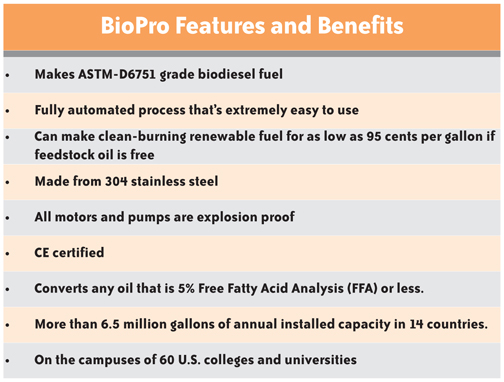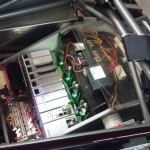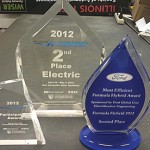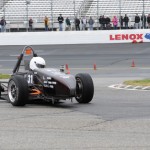A student team, lead by Donald Ruffatto, from the Illinois Institute of Technology (IIT) SAE International chapter contacted AutomationDirect in late 2011, asking detailed questions about our Productivity3000 Programmable Automation Controller (PAC). They were planning to use it to control an electric car that they were building for the Formula Hybrid International Competition, hosted by the Thayer School of Engineering at Dartmouth, the IEEE, and SAE International, to be held at the New Hampshire Motor Speedway in Loudon, NH, at the end of April 2012.
Thirty-nine teams from universities throughout the U.S. and nine countries registered for the competition, but the challenging requirements narrowed the field to just 30 competitors from the United States, Spain, and Canada by the time of the event.
The competition is intended to foster creative solutions by university-level students to problems in energy efficiency and related vehicle design for hybrid and electric formula racing cars. IIT started preparations for both hybrid and electric racing cars for the competition, but as the competition’s deadline approached, the SAE students decided to pour all their efforts into the electric car.
During those initial phone calls, the students’ know-how and ambitious plans quickly impressed the technical personnel at AutomationDirect. Within a few days, they agreed to allow the students to become ‘Beta testers’ for the unreleased P3-HSI (High Speed Input) module that was needed to implement several aspects of their sophisticated control scheme.
The students explained how they planned to use four independent electric ‘hub motors’, one in each wheel, which would require software functions not needed with a more traditional drive train. All cars require a differential to allow the outside wheels to turn faster than the inside wheels in a turn, otherwise the car will try to flip over.
The students needed to create an electronic differential (or ‘e-diff’) in the PAC, but they went on to explain that the e-diff would be adjustable, and would work in conjunction with other algorithms to actually improve the cornering capabilities of the car even further.
The team detailed their plan to implement ‘launch control’ and ‘traction control’, also via software in the PAC. These concepts use high-speed monitoring of AutomationDirect proximity sensors at each wheel to monitor impending wheel spin (in both acceleration and during cornering) and to allow the application of maximum power at each wheel during any maneuver.
“After agreeing to sponsor the team, we didn’t hear from them until we called for feedback,” said Richard Palmer, a member of the AutomationDirect Business Development team who coordinated the beta testing effort for the P3-HSI and P3-HSO modules. “They were clearly comfortable and competent users of the PAC hardware. After several weeks of testing by the users we called for feedback and received excellent comments on the HSI and HSO modules from all of the beta customers. The IIT team and all the other users who helped us with beta testing certainly contributed to improving the two Productivity3000 high-speed modules that we sell today.”
The team also implemented two six-inch C-more Micro HMI panels on the car, one as an ‘e-dashboard’ that allowed the driver to view important information from the battery management system, such as the state of charge for the battery pack, and to monitor the four independent motor controllers. The e-dashboard was also used to initiate startup and shutdown sequences (controlled by the PAC) for the car, as well as a standard speedometer function.
The second C-more Micro was mounted on the rear of the car, and was used in between competition runs to adjust various parameters, including a governor function (for the maximum endurance runs), the electronic differential parameters, and also to ‘trim the pots’ associated with the steering and pedal feedback values used by the PAC to control the car. The rear mounted C-more was also used to display lap times, maximum g-forces, and to control the charging of the battery pack while the car was plugged into the power grid. The two C-more Micro panels were connected to the Productivity3000 via serial communication and all data was supplied through the PAC.
The electric car was built at IIT over a span of about five months, with students working 10 to 12 hours per week and, toward the end of the preparation period, probably that many hours each day.
Pavel Dutov, the President of the IIT SAE International chapter and a PhD candidate in Chemical and Biological Engineering, estimated a rough approximation of labor at about 6,000 hours, or the equivalent of three persons working full-time for a year. At any given time, at least ten students were assembling or testing on the vehicle.
Simply making it to the competition was quite an achievement. Pavel Dutov explained, “The challenge, for a student competition, is to construct a working car with limited resources and time – that can also satisfy all the safety requirements.” Dutov said, “It is a student competition, so judges have to be pretty sure that the car is safe before they allow the students to drive it in race conditions. This year there were 30 teams present, but only one-third had functioning cars that were able to pass the technical inspection.”
The competition included static judging as well as the on-track competitions:
1. Teams were required to make a 20-minute marketing presentation, outlining features of the car and its design innovations. This presentation was given by team member David Wylen, a junior in Mechanical Engineering. The IIT team was awarded fourth place.
2. Teams then submitted their car to the Design Judging event, in which each of the committee judges inspected the vehicle and questioned team members about a different aspect of the car – suspension and braking, performance, power train, and efficiency. The results of the design judging were used in conjunction with the event results for the overall evaluation of the cars.
Moving to the track, the cars competed in separate Acceleration, Autocross, and Endurance events:
1. The Acceleration event was essentially a drag race, a timed 75-meter run.
2. The Autocross event challenged the driver and the car to maneuver as quickly as possible through a tight, twisting road course, marked with cones, designed to test cornering, speeds, and other aspects of real-time driving.
3. The final event tested the car’s endurance; perhaps the most challenging of all. Teams attempted to run their vehicle 36 laps, a total of 15 miles, continuously on the Loudon track. Of all the purely electric cars in the competition, only the IIT entry finished the Endurance portion of the competition.
IIT chapter president, Pavel Dutov, considered the Endurance event the biggest challenge, “Endurance is the biggest, most difficult and important event, and we won it!
“Before the Acceleration event, we still had some issues with the car and worked on it all night,” Dutov said, “so even though our car was very powerful and light, we only managed to win fourth place.” His teammate Nicolas Crivelli agreed, adding that even though the IIT team had worked on the car around the clock, that some of the electrical power connections hadn’t held up under race conditions. Team members are convinced they could have won this event; after all, the power to weight ratio of the car yields a theoretical 0-60mph time of 3.4 seconds. The team is confident that they have achieved actual 0-60 times in the 4 to 5 second range, but just not during the officially timed event.
Their Autocross run was also judged against time. The IIT team completed the Autocross course in 38 seconds which put them in second place; the fastest score recorded was 31 seconds, by the University of Kansas. Here too, the IIT team is convinced that, with a little practice, their results would have been better.
Regarding the Endurance event, team member Stamen Tintikov (now a senior, studying Mechanical Engineering), who was also in charge of IIT’s hybrid entry said, “We were the only electric car capable of finishing in this event, and it means something because it’s electric-only: hybrids have a combustion engine on-board the vehicle, so they can always switch to gas.”
“We designed our all-electric car to go exactly fifteen miles at optimal performance,” Dutov added. “If you design it to go any further, then you’ve overengineered it.”
IIT took second place overall in evaluation of the electric racing car, as well as second place for the Ford Efficiency Award, awarded to the vehicle judged best able to get maximum running results from a minimum amount of fuel or electric energy. They placed among the top six entries contending for the Institute of Electrical and Electronics Engineers (IEEE)’s ‘Engineering the Future Award’ and the ‘Excellence in EV Engineering Award’. In addition, IIT scored several ‘firsts’ in the judging categories which contributed to these results.
Eleven SAE team members from IIT went to the Competition. Four of them drove the electric car. Many lost a good deal of sleep working all hours to complete last-minute preparations. All their efforts continued: “The reality is, we did pull all-nighters,” said Nicolas Crivelli (also a senior in Mechanical Engineering). “Three of those days we had issues with the car and worked nearly around the clock to fix them, and did, which surprised the judges and many other teams.”
We asked the team what made the IIT vehicle distinctive, and how it contributes to engineering science for sustainability and efficiency?
“The car is interesting because it was built by engineers who are not familiar with the car industry at all,” Donald Ruffatto said, “building it from scratch, using our own ideas and not imitating well-known automotive approaches. We had the innovative idea of hub motors, attaching an individual motor to each of the four wheels, which gave us an independent four-wheel drive system to work with. This is something you cannot get on any gas car.
“The approach has a lot of advantages. We could apply torque to each wheel independently and improve both efficiency and how well the car could handle.
“We also had regenerative braking on this car, which enhances efficiency. Instead of wasting the energy in braking which, in regular cars, gets converted into heat, we used the motor on each wheel as a generator to transfer the kinetic energy back into the electrical system and to recharge the batteries.
“Our system was also unique in that the motors on each wheel were identical. This meant that we created a modular system that was easy to control, easy to troubleshoot.”
This design decreased the total weight of the car and provided better weight distribution. Software algorithms enabled greater precision and efficiency in channeling the torque output required for specific maneuvers, such as tight cornering, acceleration, and braking.
Another innovation, at least for a student-built racing vehicle, was the use of a professional-grade material, carbon fiber, in crafting the “A-arms,” or “wishbones”, which link the wheels to the chassis. “The uniqueness is in the material we used – carbon fiber, which is super-light and is extremely strong,” Tintikov said. “We tested each link to 2,000 pounds of tensile stress, which is considerably more than is needed in a race.” The use of carbon fiber dramatically decreased the weight of their chassis, compared to a standard automobile. The team boasted that the weight of the vehicle’s entire suspension system was less than ten pounds, and the entire car weighed in at 604lbs. at the competition.
One of the competition’s goals is student participation in real world problem solving. Dutov explained, “One of the main things was learning from our mistakes. We had front and rear wings on the car that cracked because we hadn’t realized that the car could turn so sharply that it would shake the wings violently. It worked perfectly in 2D simulations and in our aerodynamic calculations, but in school you study theory, and real life experience provides an extra degree of freedom which you never know until you face the real application.”
“Gas prices go up day by day, and by this point it’s obvious the future is for electric and hybrid vehicles. Electric car racing is the best way to test the limits and move the industry forward.”
2012 Team members included: Donald Frank Ruffatto, Alexander Luke Lambert, Nicolas Raul Crivelli, Charlie Currier, Frank Iamarca, Bart Patrzalek, David Wylen, Manuel Leon Madrigal, Daniel Milewski, Stamen Tintikov, Anthony Perri, Carlos Sosa, Rodolfo Manotas Ramos, Nicholas Krause, and Nikola Micic.
By Chip McDaniel
Disclaimer: “AutomationDirect does not guarantee the products described in this article are suitable for your particular application, nor do we assume any responsibility for your product/system design, installation, or operation.”
Originally Posted: March 1, 2013






